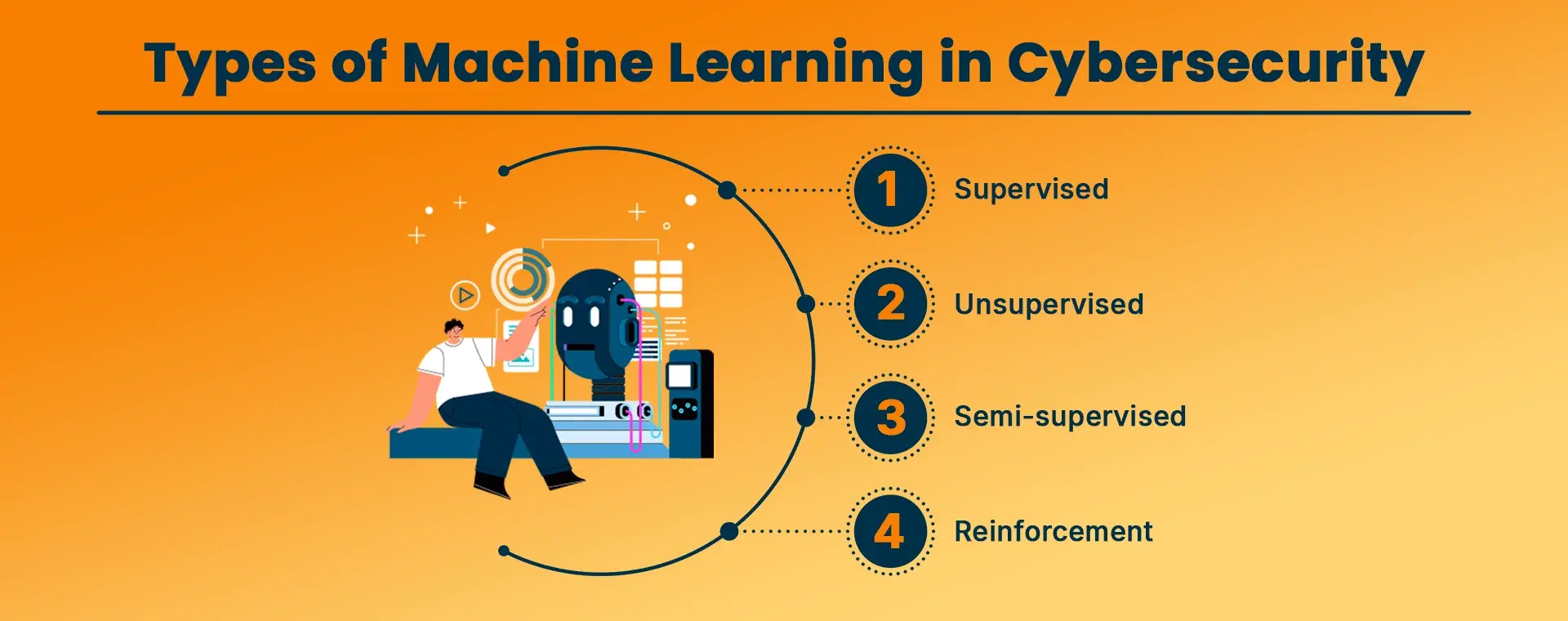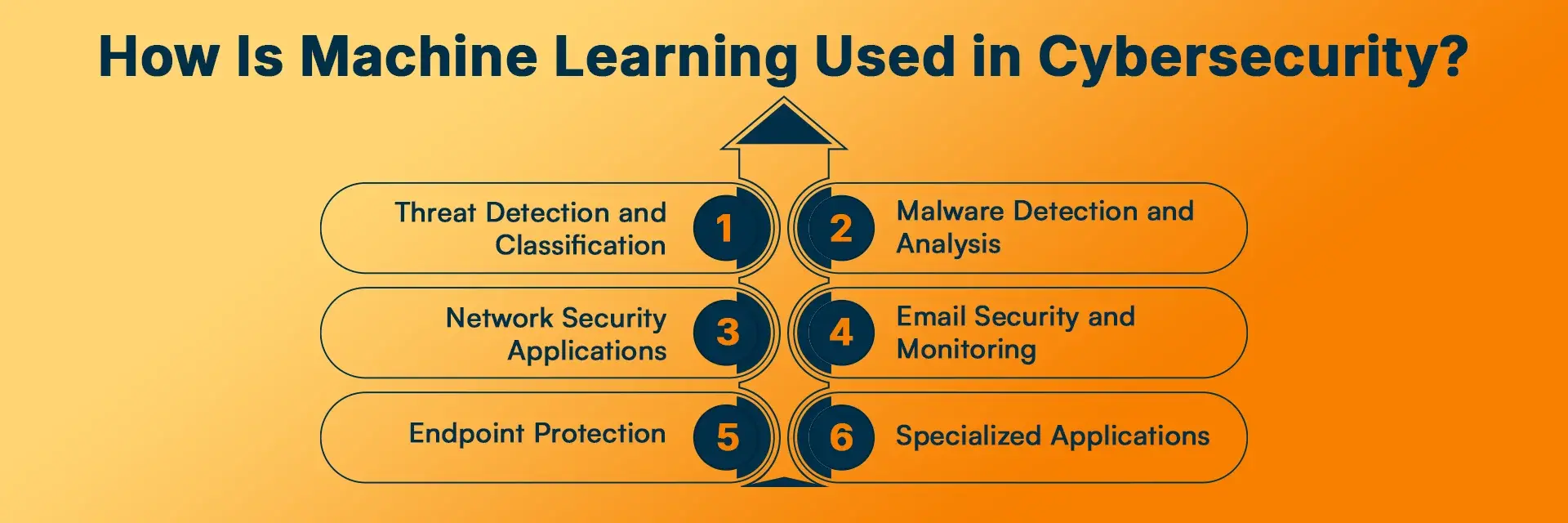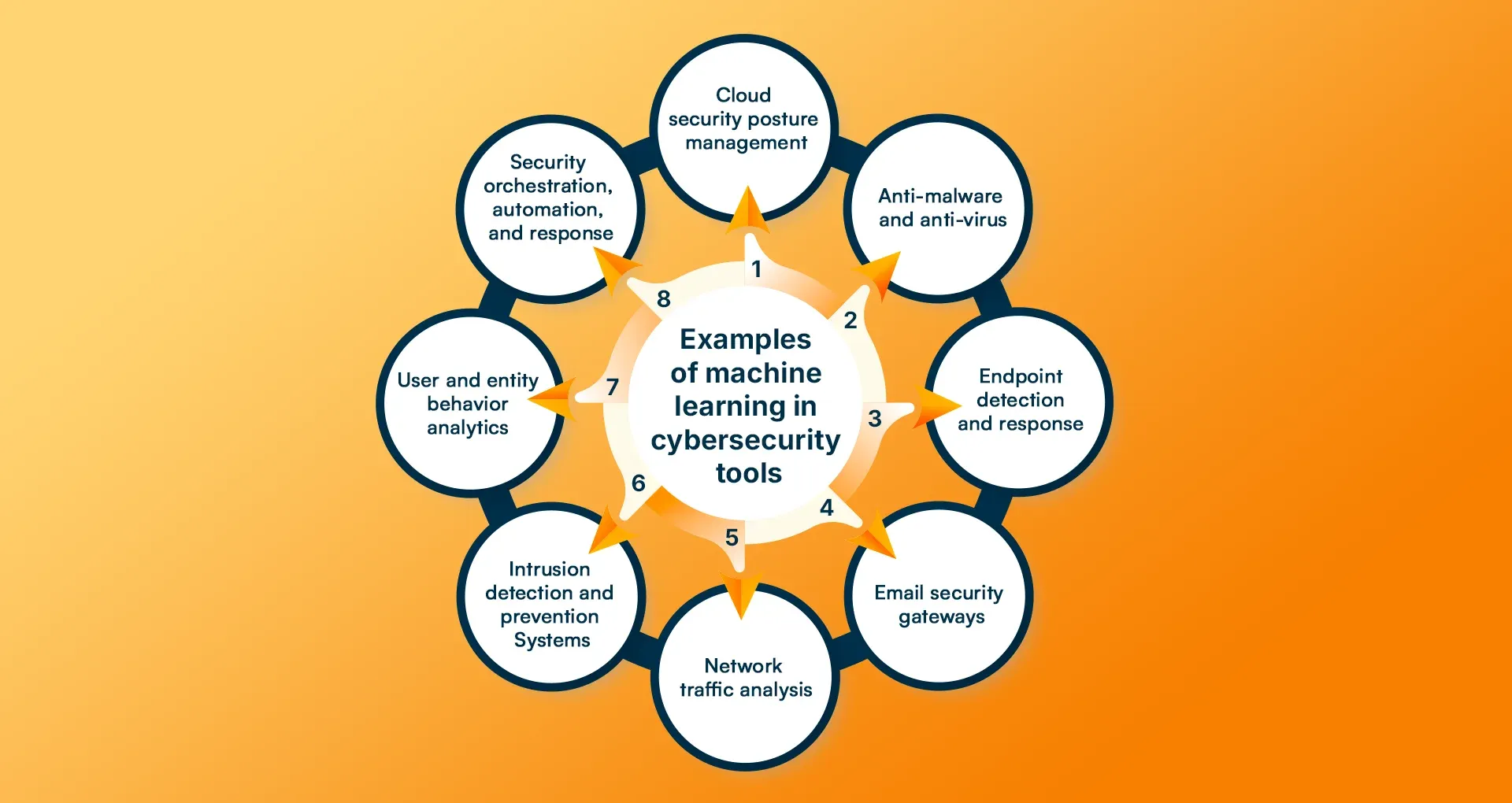
We hear about cyber fraud in the news every day. From this, we come to know how fast cyber threats are evolving, and each cyber threat gets smarter and more complex than the previous one. In 2025, the whole world will have lost $10.5 trillion dollars due to cybercrime. Ransomware campaigns to phishing scams, and zero-day exploits are happening every day. Today, most of the attackers do not even use brute force, but they use sophisticated techniques that can easily bypass traditional security systems.
I have spent many years using AI and ML-powered security tools, and from my experience, I can confidently say that machine learning should be made essential and not optional for cybersecurity. While older security measures react to an incident, ML-driven solutions continuously learn and adapt according to new attacking patterns and respond in real time.
In today's detailed article, we will practically learn about the benefits of using machine learning in cybersecurity and its real-world use cases. By the end of the article, you will understand how important role machine learning plays in cybersecurity.
Quick Summary
Machine learning transforms cybersecurity into defensive systems, making them smarter, faster, and more adaptive. Using it practically brings many benefits, such as it can detect threats in real time, reducing false positives, and giving automated responses accordingly, which is why machine learning security is considered scalable protection.
Machines can easily handle threat detection, malware analysis, network security, email protection, and SOC operations in the Cybersecurity sector. There are many companies that use machine learning to further enhance cybersecurity.
Our Focus in this article:
1. What is machine learning, and how does it help in cybersecurity?
2. How does machine learning bring transformation in cybersecurity, and how can companies implement it?
3. How can you use machine learning for cybersecurity purposes in your business?
What is Machine Learning?
If we understand machine learning in simple words, then it is a branch of Artificial Intelligence that helps in teaching computer systems, and it uses computer systems for teaching instead of complex programs. Actually,it does not teach the computer step by step but feeds it with large amounts of data, and the system understands itself from the patterns, relationships and insights of that data.
For example: In traditional programming, developers used to manually write rules, like if a mail contains a word "lottery" then mark it as spam, but such rules can be easily manipulated by attackers. But machine learning is trained on the data through which the system can know which mail is genuine or which is spam or phishing mail. Because it has a lot of samples, which it uses to try to detect suspicious patterns.
The key components of ML are
- Algorithms: This can be called the brain of machine learning; it processes the data by finding patterns.
- Data: It uses real-time inputs and historical data to train the models.
- Models: This is the trained agent of the system, which can make predictions and decisions.
What makes machine learning different from traditional programming is that it is adaptive, predictive, and constantly improving as it matures. In cybersecurity, this adaptable nature helps the system detect zero-day attacks or unusual behaviours.
The Role of AI and Machine Learning in Cybersecurity
As I have seen, most companies’ cybersecurity is quite reactive, trying to detect known threat issues like signatures, blacklists, and static rules. While it is effective against well-documented attacks, it is not capable of stopping zero-day exploits, advanced persistent threats (APTs), and polymorphic malware attacks because such attacks repeatedly mutate themselves to avoid detection, so no amount of programming done in traditional systems will be able to control modern attacks.
In the last few years, I have seen a massive shift in cybersecurity, and companies are using machine learning for their security. Because machine learning not only tracks corrupted files from the database, it also tracks patterns of future threats.
For example, if an application suddenly starts encrypting hundreds of files, machine learning will detect that it could be a ransomware attack, even if it has not seen the malware strain before.
Here’s how AI and ML are transforming cybersecurity
- Pattern Recognition: ML tries to identify unusual patterns in user activity, whether it is through the system or through the network.
- Automation of Security Processes: Machine learning can easily handle many repetitive tasks, such as log analysis, malware classification, or alert triage, and can automate all these tasks in seconds, saving analysts' time and allowing them to make strategic decisions.
- Predictive Threat Analysis: Machine learning uses historical data for learning and predicts potential vulnerabilities and attacks before they happen.
How Machine Learning Transforms Cybersecurity
When I was exploring Machine learning tools for cybersecurity, I was most surprised by the working speed of machine learning tools, because traditional systems would often choke if terabytes of logs had to be scanned, but machine learning models can process the same data in milliseconds, and if there are anomalies in it, it can detect them in seconds, as compared to humans.
How machine learning is fundamentally transforming cybersecurity
1. Speed and Scale Advantages
Cyberattacks expected in 2025 are very fast, and ML provides more speed than that for security, due to which it becomes easier to defend the system and databases of millions of files can be scanned in seconds. Whether it is endpoints or network connections in real time, what is its current status, machine learning can handle all this security very speedily.
And this level of security and monitoring cannot be done manually or by traditional programming.
2. Adaptive Learning Capabilities
A static security system works on a fixed path, but ML evolves on its own. Whether every attack is successful or not, it trains itself using that data. And this allows the model to refine itself a lot, which makes it capable of stopping cyberattacks.
3. Proactive vs. Reactive Security
Traditional security waits for a breach to take action, but machine learning works in proactive ethics, which means it remains aware of the attacking trends and automatically makes the systems defensive accordingly so that the attack is not successful, apart from this, if it finds an issue in any part of the system, like if it finds any login suspicious, then it can suspend the login attempt from that IP address.
4. Integration with Existing Infrastructure
The best thing about ML is that it does not replace existing tools but enhances their security. Be it SIEMs, firewalls, or endpoint detection platforms, machine learning collaborates with all of them to make them smarter and defensive, which allows all security tools to remain context aware.
This is why machine learning security systems can easily detect zero-day attacks and ransomware attacks and can automatically respond accordingly. And this also reduces false positive cases. In simple words, you can understand machine learning as a proactive firewall which tries to update itself before the attacks occur.
Types of Machine Learning in Cybersecurity
All companies have different cybersecurity problems and requirements, so all require different learning approaches. Over the years, I have worked with many ML-powered security tools, and I noticed how different learning methods impact their detection accuracy, scalability or adaptability. Let’s understand this in some detail.

1. Supervised Machine Learning in Cybersecurity
You can understand supervised learning as if you are teaching a child using flashcards, in this, you provide examples and give time to the system so that it can understand their differences.
- Definition & Characteristics: These models are trained on large datasets, and the data can be in the form of predefined labels.
- Applications: They are trained on malware classification, spam detection, and phishing email filtering.
- Example: I once configured a spam detection ML that was trained on millions of real-world email data. It could easily spot suspicious subject lines, abnormal sender patterns and also distinguish phishing URLs with a fair amount of accuracy.
Supervised ML provides pretty good accuracy if you have plenty of labelled data available, but it struggles a lot for brand-new threats.
2. Unsupervised Machine Learning in Cybersecurity
Unsupervised learning works without labels, allowing you to understand the pieces of a puzzle and then guess how they will eventually fit together.
- Definition & Characteristics: These models learn by identifying hidden patterns or groupings from unlabeled data.
- Applications: Unsupervised Machine Learning helps in anomaly detection, network behaviour analysis, and insider threat identification.
- Example: I consulted a financial institution last week that uses unsupervised ML to detect unusual login activity. And it froze the account of an employee who was logging in from foreign locations during odd hours, and as it was an exact sign of cyber threats, it blacklisted these login attempts.
Using these methods, it becomes quite easy to detect unknown or zero-day threats.
3. Semi-Supervised Machine Learning in Cybersecurity
Semi-supervised learning is best for both worlds and uses small sets of labelled data and unlabeled data.
- Definition & Characteristics: It combines supervised and unsupervised approaches to reduce labelling costs.
- Applications: This system provides features like Threat intelligence classification, user activity monitoring, and scalable malware analysis.
- Example: I have seen this in SOCs (Security Operations Centres) where analysts only manually use labels to detect suspicious files, and the ML model extrapolates that knowledge to thousands of others.
This is cost-effective and powerful and is best for organizations that do not need massive labelled datasets.
4. Reinforcement Learning in Cybersecurity
Reinforcement learning seems quite futuristic because it works on trial-and-error with feedback, so you can understand reward and punishment like this. And this learning model can understand you like humans.
- Definition & Characteristics: These models learn by interacting with the environment and adjust the results accordingly.
- Applications: It has expertise in adaptive intrusion detection, firewall optimization, DDoS mitigation, and cyber-physical system security.
- Example: I used reinforcement learning for experimental systems to dynamically adjust firewall rules in real time, as a simulation, so that it could be faster in response than human administrators.
Reinforcement learning is still evolving, and hence it is in the early stages and in the future it could become the backbone of autonomous cybersecurity systems.
All of these machine learning approaches have their own unique strengths. You can call supervised as precise, and unsupervised follows exploratory, and semi-supervised efficiency and reinforcement learning follows an adaptive path. All these together build a defensive layer system for both predictive and responsive systems.
Also Read: Benefits of Machine Learning in Healthcare
How Is Machine Learning Used in Cybersecurity?
In the last few years, I have experienced and tested a lot of ML-powered cybersecurity tools. This made me realise that machine learning does not just give you one feature, but it is spread across all layers of security, be it endpoints or free network or cloud and SOC operations. It does a step-by-step breakdown.

1. Threat Detection and Classification
The most powerful feature of machine learning is its ability to detect threats and classify them correctly.
- Advanced Persistent Threats (APTs): These are long-term models that protect the system from 24/7 attacks. ML models can track subtle behavioural shifts that human analysts can easily miss.
- Zero-day Attack Detection: Compared to signature-based systems, ML models can detect new issues by analyzing unusual activity that can exploit the system.
- Behavioral Analysis: I have seen many such ML tools that judge on the basis of profiles whether the user is genuine or not, or what is his login IP and most social media platforms also use this system to protect their platform.
Real-world note: Microsoft once used ML to protect its system from a crypto-mining attack and filter data of 400,000 infected users. Their machine learning Windows Defender can instantly detect such attacks.
2. Malware Detection and Analysis
As we know, malware evolves constantly, and sometimes it changes your code automatically, and such malware is called polymorphic malware, and it changes itself so that it can avoid detection.
- Static Analysis: Machine learning systems can examine known malicious files and find their characteristics accordingly.
- Dynamic Analysis: ML sandboxes files and tries to observe real behaviour accordingly.
- Polymorphic Malware Identification: Machine learning tries to spot and learn underlying malicious intent, which helps the malware advance further.
- Automated Reverse Engineering: An advanced machine learning system breaks down malware functions and classifies them accordingly, faster than a human team.
From my experience: ML-based malware scanners are significantly better at identifying brand-new malware samples, and compared to legacy antivirus tools, ML is more effective.
3. Network Security Applications
Networks generate massive datasets and amounts of traffic logs every second. And humans cannot realistically analyze this, but machine learning systems can.
- Intrusion Detection Systems (IDS): ML models can spot unusual access attempts or port scans.
- Traffic Analysis: Its algorithms can flag unusual data transfer volumes or connections to suspicious domains.
- Connection Pattern Recognition: If an endpoint suddenly starts communicating with dozens of foreign IPs, ML can recognize suspicious activity and flag or blacklist it.
I have seen ML-powered IDS that prevent lateral movement in corporate networks by detecting abnormal communication between employee devices, so that even if the admin panel is compromised, it can protect it.
4. Email Security and Monitoring
Emails have been the biggest entry point for cybersecurity in the last 10 years, as email has become a very common source of service and professional community these days, and attackers have found many new ways to phish through emails.
- Phishing Detection: ML Models analyze text sender reputation and hidden URL structures.
- Spam Filtering: Traditional systems used keyword-based filters, but ML Models evolve using spam techniques.
- Business Email Compromise (BEC) Prevention: Machine learning can even flag such emails, even if they come from the CEO’s official email.
Many modern email security gateways today rely heavily on machine learning to protect organizations from cyberattacks.
5. Endpoint Protection
Many cybersecurity breaches happen through endpoints, of which laptops, mobiles, and IoT devices are the most common, and they are also considered the weakest secure systems. Machine learning helps to further strengthen the defence of these endpoints.
- Device Behavior Monitoring: In this, if it sees a device suddenly doing abnormal work, from a software perspective, it can spot it and temporarily shut it down or disable its network connection.
- Mobile Security: It flags rogue apps and malware targeting Android/iOS devices and pays special attention to their application permissions and ensuring that no app is running unauthorised.
- Real-time Response: It instantly quarantines any device suspected of being compromised, before the infection can spread.
In practice, ML-powered endpoint detection and response (EDR) tools act in milliseconds, which is much faster than human SOC teams.
6. Specialized Applications
This is a far cry from machine learning basics and is increasingly being used in specialized cybersecurity areas.
- Web Shell Identification: This can easily detect malicious scripts hidden on servers.
- DDoS Prevention: This can recognize early botnet patterns, so that large-scale attacks can be avoided.
- Application Security: ML can effectively identify abnormal API usage or suspicious traffic in SaaS platforms.
- Network Risk Scoring: It prioritizes vulnerabilities that could exploit the system and tries to remove them.
- Firewall Rule Optimization: Machine learning continuously fine-tunes the firewall so that it can block emerging threats.
- Supply Chain Attack Detection: It monitors dependencies, vendor networks, and third-party risks in great detail.
- Threat Hunting & Forensics: Machine learning provides analysts with pre-sorted or high-confidence leads.
- SOC Enhancement: It automates log analysis and incident triage to save analyst time.
I’ve worked with SOC teams, and I can say that ML dramatically reduces “alert fatigue” because analysts can’t check 10,000 alerts a day, and machine learning saves them a lot of time by automating this work.
In Short, Machine learning has added proactive capabilities to all layers of cybersecurity, from emails to endpoints to cloud and SOC. Machine learning enhances speed, accuracy, and automation, giving defenders an upper edge.
Benefits of Machine Learning in Cybersecurity
Based on my personal experience, I can say that machine learning security tools are quite effective and have many benefits. All these benefits combine to greatly increase the speed, accuracy, and adaptability of security tools. Let us break down its advantages.
1. Real-time Analysis and Response Capabilities
There are millions of cyber threats every millisecond, and traditional systems respond quite late, which makes it very difficult to avoid threats. ML Models process massive datasets in real time while detecting anomalies, and for that, they quarantine suspicious files and block IPs in seconds. This rapid response drastically reduces the potential damage.
2. Improved Accuracy in Threat Detection
Machine learning continuously learns according to new threats. And over time the models keep getting better and it easily distinguishes malicious or benign activity. This means that threats are reduced significantly and this leads to better classification of emerging attacks like zero-days and advanced phishing schemes.
3. Reduction in False Positives and Negatives
The biggest frustration of cybersecurity is tackling false alerts, because whether the alert is false or positive, the analyst staff has to check it in great detail and ML refines the problem a lot, with high accuracy detection based on contextual analysis and feedback loops. So that the analysts can focus all their attention on genuine threats. This not only improves efficiency but also prevents “alert fatigue”, so that if real threats arrive, the team can focus completely.
4. Scalability in Handling Large Volumes of Data
Most businesses are moving to cloud and IoT these days because the data of businesses has become so much that traditional systems cannot secure it. And machine learning is solving this issue to a great extent because it can handle millions of logs, network flows, and endpoints in seconds. This gives enterprises the facility of wide protection and it gives more time to human teams for security scalability.
In short: Machine learning not only makes cybersecurity smarter but also makes it faster, more accurate, and scalable no matter how big the size of the company. Such companies that face constant attacks may prefer machine learning.
Machine Learning Cybersecurity Tools and Technologies
One thing I have noticed from my experience is that machine learning in Cybersecurity is not just a theory but it has become quite practical in today's time. And it has already started getting embedded in today's modern security. Whether it is detecting phishing emails, monitoring endpoints, or automating SOC workflows, machine learning provides an extra security layer to Cyber defense.

1. Cloud Security Posture Management (CSPM)
As we know that cloud environments are very complex and they are constantly changing configurations.
- ML Role: ML can easily detect misconfigurations, enforces compliance and easily predicts risky settings of AWS, Azure, and Google Cloud.
- Example: Tools like Prisma Cloud use machine learning to avoid risky settings so that attackers cannot exploit their system.
2. Anti-Malware and Anti-Virus Solutions
Traditional antiviruses rely on system signatures, but attackers nowadays create polymorphic malware that constantly changes so that they can bypass security.
- ML Role: For this, it uses behavioral-based detection rather than static signatures.
- Cloud-Assisted Analysis: Cloud-based machine learning models instantly update themselves to avoid millions of endpoints in real time and protect systems.
- Example: Next-Gen Antivirus (NGAV) platforms like Cylance (now BlackBerry) heavily rely on machine learning to stop threats before they are executed.
3. Endpoint Detection and Response (EDR)
Endpoints are a favorite target of attackers, so securing them becomes very important.
- ML Role: Machine learning provides alerts for advanced threat hunting, device behavior monitoring, and automated remediation, so that large threats can be avoided.
- Example: CrowdStrike Falcon EDR uses machine learning to detect malicious behavior in endpoints and responds instantly accordingly, often activating before an attack occurs.
4. Email Security Gateways
Phishing is still a leading cause of data breaches, so email defense also plays a very critical role.
- ML Role: These subjects can easily scan lines and easily detect sender reputations, and embedded links for anomalies.
- Content Analysis: These try to detect suspicious things in content or hidden codes according to their language patterns.
- Example: Machine learning powdered emails are gateways that use advanced filter systems, in which they can easily detect phishing and Business Email Compromise (BEC) attempts.
5. Network Traffic Analysis (NTA) Tools
Modern networks generate a very large amount of data.
- ML Role: It performs deep packet inspection, flow-based monitoring, and encrypted traffic analysis to identify hidden threats.
- Example: Darktrace system uses unsupervised ML to detect anomalies of network behavior and alerts.
6. Intrusion Detection and Prevention Systems (IDPS)
Legacy IDS systems struggle a lot with false positives. And ML fixes these problems to a great extent.
- ML Role: It analyzes host and network data to spot true intrusions.
- Hybrid Deployment Models: It combines with cloud data to make the response faster.
7. User and Entity Behavior Analytics (UEBA)
As we know, detecting insider threats is very difficult because it involves legitimate users.
- ML Role: It tracks user activity, including login times, resource access so that the system can be blacklisted based on the level of risk.
- Example: Systems like Splunk UEBA use ML to detect compromised accounts or insider misuse before they are damaged.
8. Security Orchestration, Automation, and Response (SOAR)
Security teams feel overwhelmed with thousands of daily alerts.
- ML Role: They automate triage, incident management, and response workflows.
- Integration: They connect SIEMs, firewalls, and ticketing systems to reduce manual work.
- Example: Swimlane Turbine combines machine learning with low-code automation to speed up SOC operations.
All of these tools work together to provide extra security to the defense layer, thanks to machine learning. And today, because of firms like RejoiceHub, machine learning is not a premium feature, anyone can easily deploy it in their Business system through experts and this fixes their cybersecurity solutions to a great extent.
Also Read: Best Machine Learning Frameworks in 2025
Machine learning challenges and considerations
Although machine learning has brought a lot of revolution in the field of cybersecurity, from my experience so far I have learned that it is not always easy to adopt ML-based systems. Organizations have to face many challenges to use these tools properly. So let's look at the main challenges:
1. Technical Challenges
- Data Quantity and Quality: Large and high accuracy data sets are required to run ML models properly. If the data is partial, less and incomplete then the model will give wrong results. In cybersecurity, sensitive data alphabet is less and restricted due to which problems increase to a great extent.
- Algorithm Selection and Tuning: It is very important to choose the algorithm according to the problem. For example, an unsupervised model is needed for anomaly detection, while a supervised model is needed for malware classification. If the tuning is not right, the threats can be ignored to an extent or there can be more false alerts.
- Model Interpretability: Many ML models work like a "Black Box". But in regulated industries it is not enough to just say that "the model identified it as malicious". Analysts also have to explain why.
- Adversarial Attack: Now the target of hackers is only the ML model. For example - attackers can mislead the model by feeding it "dangerous" data so that it identifies the threats in the wrong way. And this has created a new battlefield - adversarial AI
2. Operation Challenges
- Integration Complexity: Integrating ML models into existing cybersecurity infrastructure (firewall, SIEM, SOC workflows) can be a bit technically difficult
- Skills Gap: There is a shortage of experienced data scientists and ML engineers. Many times security teams do not have the experience to run and manage models properly.
- Cost Considerations: ML systems require heavy computing power, storage and periodic updating. This can prove to be quite expensive for small scale businesses.
- Maintenance and Updates: ML models should always be re-trained with fresh data. If maintenance is not done from time to time, it becomes old and ineffective.
3. Ethical and Legal Considerations
- Privacy Concerns: Collecting massive user and network data raises questions about privacy compliance (GDPR, HIPAA, etc.).
- Bias in Algorithms: If training data is biased, ML models may unfairly flag certain users or overlook specific threats.
- Regulatory Compliance: Governments are tightening rules around AI in sensitive areas like finance and healthcare. Cybersecurity ML must align with these regulations.
- Transparency Requirements: Organizations must ensure explainability, fairness, and accountability in ML-powered decision-making.
In short: While ML is powerful, poor implementation can create more problems than it solves. To succeed, businesses must address technical, operational, and ethical challenges head-on.
Companies Leading Machine Learning in Cybersecurity
Many global technology leaders are innovating in machine learning powered cybersecurity tools. From my experience, let me tell you about the unique specialties of all the top companies that are playing a very important role in Cybersecurity.
1. Microsoft
Microsoft has invested a lot in machine learning based cybersecurity to make their ecosystem more threat proof.
- Azure Sentinel: This is a SIEM based cloud-native that uses machine learning for intelligent threat detection and it handles automated incident response, and advanced analytics very effectively.
- Windows Defender: The best example of machine learning in the Cybersecurity world was seen in 2018 when a massive crypto-mining malware attack was stopped in 12 hours and data of 40,000 users was protected.
- Cloud Security Innovation: Microsoft integrates machine learning into all its cloud platforms to ensure scalability and updates in real time while also working against emerging threats.
I have noticed that Microsoft keeps its main focus on scale and automation and for this it is trying to make machine learning more accessible for large and small businesses.

2. BlackBerry (Cylance)
This was a popular brand in the smartphone category, but BlackBerry has become a security powerhouse now that it has also acquired Cylance to handle endpoint security.
- CylancePROTECT: It uses machine learning to detect zero-day threats without relying on signatures and also makes future predictions of threats.
- Endpoint Security: It focuses on lightweight, proactive defense for enterprises.
- Zero-Day Prevention: Cylance models easily block malware before it executes, drastically reducing infection rates.
I have seen a lot of enterprises adopt Cylance for its predictive, prevention-first approach.

3. Crisp Thinking Inc
Crisp specializes in behavioral analytics and fraud detection.
- Real-time Risk Monitoring: It detects harmful speech, brand impersonation, and fraud on social channels.
- Reputation Protection: Helps brands safeguard their online presence.
- Fraud Detection Systems: Identifies patterns of abusive or manipulative behavior across platforms.
Crisp’s strength lies in social media and online community protection, which many traditional cybersecurity tools overlook.

4. Forcepoint
Forcepoint focuses on human-centric cybersecurity.
- Risk-Adaptive Protection: ML continuously evaluates user behavior to detect high-risk actions.
- Data Loss Prevention (DLP): Monitors sensitive data movement across networks and devices.
- Cloud Access Security Broker (CASB): Protects SaaS and cloud environments using ML-driven insights.
Forcepoint is unique because it blends user behavior analysis with data security, reducing insider threat risks.

5. Splunk
Splunk is best known for SIEM and log analytics, but it also integrates ML.
- Splunk Enterprise Security (ES): Uses ML to automate breach investigations.
- Splunk User Behavior Analytics (UBA): It detects compromised accounts and insider threats.
- Machine Learning Toolkit: It allows security teams to customize ML models for unique organizational needs.
I've seen Splunk help SOC teams cut investigation times from hours to minutes.

6. Chronicle (Google Cloud)
Chronicle's parent company is Google, which has quite large datasets, and hence it focuses on large scale data analysis.
- Backstory Platform: It analyzes massive volumes of security telemetry and tries to simplify complex threats and take actionable steps using its intelligence.
- Large-Scale Data Processing: It’s built into Google’s infrastructure, making it ideal for enterprises looking to secure security logs.
- Threat Detection Capabilities: It uses machine learning to correlate anomalies, and has the ability to adapt to multiple environments.
Chronicle is very powerful for organizations that have huge datasets but limited analyst capacity.
All of these companies are far ahead in machine learning-based cybersecurity innovation, and they all try to tackle different aspects and problems.

The Future of Machine Learning in Cybersecurity
As per what I have observed, I can say that machine learning is going to have a very evolving future in cybersecurity as many big giants are doing new innovations, let’s understand this in detail.
1. Integration with Emerging Technologies
ML will increasingly work alongside technologies like blockchain, edge computing, and IoT security frameworks. As billions of new devices connect to networks, ML models will become the backbone of scalable and automated defense.
2. Quantum Computing Implications
Quantum computing has the potential to break current encryption methods, creating both risks and opportunities. On one hand, attackers may use quantum capabilities to crack systems faster. On the other hand, ML combined with post-quantum cryptography will likely form the next layer of defense.
3. AI vs. AI Security Battles
We’re entering an era of AI-powered attackers versus AI-powered defenders. Hackers are already experimenting with adversarial AI, malware that can learn how to bypass detection. In response, cybersecurity teams are training defensive ML models that adapt in real time, essentially creating autonomous “cyber battles.”
4. Predictive Security Models
Instead of waiting for attacks, ML will help organizations forecast vulnerabilities and simulate potential breaches before they happen. Think of it as “weather forecasting” for cybersecurity, where models predict the probability of a ransomware attack hitting your company in the next month.
5. Industry Evolution Trends
- More autonomous SOCs where human analysts oversee but don’t micromanage every alert.
- Wider adoption of zero-trust architectures enhanced with ML.
- Increased regulations requiring explainable AI in cybersecurity tools.
In short, the future of machine learning in cybersecurity is about speed, autonomy, and adaptability. Organizations that embrace it will stay ahead, while those relying only on legacy defenses will fall behind.
Conclusion
Today, if you need to protect your business from cyber threats, simple firewalls and signature-based antivirus tools are not enough as attackers have become quite advanced with technology and they use mutation viruses to bypass systems.
That's why most businesses have started using machine learning based cybersecurity tools or models. Since machine learning helps with everything from threat detection and malware analysis to email protection and SOC automation, if you need to upgrade cybersecurity for your businesses or deploy machine learning security solutions, you can contact RejoiceHub, a highly experienced firm of AI powered solutions.
Frequently Asked Questions
1. What are the main types of machine learning used in cybersecurity?
Total 4 types of machine learning are used for cybersecurity which are Supervised Learning, Unsupervised Learning, Semi-Supervised Learning and Reinforcement Learning. All methods have their own unique strength and they provide layered protection to most cybersecurity platforms.
2. How effective is machine learning in detecting new threats?
According to my experience, machine learning is highly effective against zero-day attacks and advanced persistent threats (APTs), because it does not rely on signatures but takes auctions according to anomalies or behavior patterns, hence it is much more advanced than traditional security systems.
3. What are the biggest challenges in implementing ML for cybersecurity?
I think there are 3 biggest challenges to face, first of all is technical because most of the companies do not have highly skilled engineers available, apart from this operations and ethical challenges are the biggest hurdles that companies have to face.
4. How do I choose the right ML-powered security tools?
For this you can follow a basic checklist, first of all you find a use case according to your system, then check the integration capabilities, after this check the reputation of that partner. And lastly calculate the ROI.
5. What skills do security teams need for ML implementation?
If you want to effectively use machine learning in your business, then your team should have these skills, the most important being data literacy, ML fundamentals, cybersecurity expertise and continuous training, these enhance the security quality significantly from all aspects.
